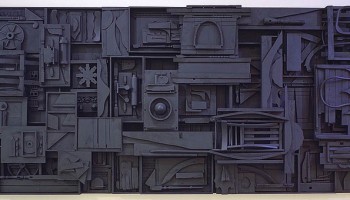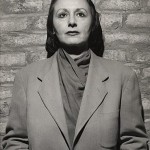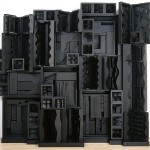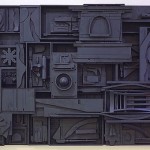Louise Nevelson

Born Louise Berliawsky on September 23, 1899 to a Jewish family in what is now known as Keiv in the Ukraine. Her and her parents, Isaac and Minna Berliawsky, immigrated to America and settled in Rockland, Maine when she was just 3 years old. Shortly after graduating high school in 1917, she married Charles Nevelson, a successful Businessman and the two of them moved to New York in 1920. Not long after moving to New York she gave birth to her son Myron in 1922.
Not content with being a housewife, she began seeking an outlet for her creative impulses. She enrolled at the Art Students League in 1929 and began to study painting and drawing. In 1931 she went study art in Europe.
Click here to continue reading this biography
Nevelson’s early works were primarily cubist figure studies made from bronze, plaster and clay, and between the years of 1941 and 1946 she exhibited her work in a series of one-woman shows. It wasn’t until 1943 that the art-world got their first glimpse of what would become Nevelson’s signature style of assembling wood. Although these pieces were not well received at the time, she would revisit this style later in her career. She continued to show her work on a regular basis throughout the next several years and in 1958 she created an exhibition titled “Moon Garden plus One”. It made such an impact that it would change the course of her career, and the art-world forever. This exhibition consisted of darkened rooms in which the walls consisted of intricately assembled black wood collages. The affects of this show were dramatic and propelled Nevelson to the forefront of American Artists and placed to as a pioneer of environmental art.
Louise Nevelson had always experimented with new mediums. While she would continue to create the wooden sculptures that made her famous; she would expand her materials to include metals and plastics and was commissioned to create many large-scale outdoor sculptures. Princeton University, Philadelphia Courthouse, and Chase Manhattan Bank were among those who commissioned these works. In 1979 an entire outdoor environment of her black painted sculptures, was constructed in New York’s Lower Manhattan..
By the time she died on April 17, 1988, Louise Nevelson was considered by many to be one of the most important American sculptors of the twentieth century and one of the world’s best-known woman artists.
- Early Photograph of Louise Nevelson
- Late Photograph of Louise Nevelson
- Untitled – 1950-1959
- Cascade – 1964
- Untitled – 1968
- Black Zag Z – 1969
- Sky Cathedral – 1982







